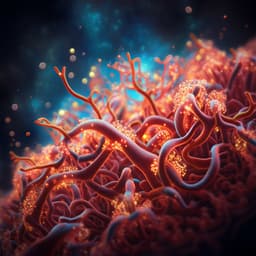
Medicine and Health
How autoreactive thymocytes differentiate into regulatory versus effector CD4<sup>+</sup> T cells after avoiding clonal deletion
X. Tai, A. Indart, et al.
This groundbreaking study explores the differentiation of autoreactive thymocytes into regulatory and effector CD4+ T cells upon escaping clonal deletion. The research reveals that TGF-β plays a pivotal role in promoting Treg differentiation by disrupting weak agonist signals, while persistent signaling favors Teff cell formation. Conducted by a dedicated team of researchers, this study opens new avenues for understanding thymic selection in immunity.
~3 min • Beginner • English
Introduction
Developing T cells are screened in the thymus for utility and self-reactivity through thymic selection. Autoreactive thymocytes with high-affinity TCRs for self ligands, together with CD28 co-stimulation, generate agonist signals. Initially, thymocytes undergo positive selection in the cortex and migrate toward the medulla, where co-stimulatory ligands with high-affinity TCR ligands induce agonist signaling. Agonist signaling in autoreactive thymocytes leads to one of three fates: clonal deletion, differentiation into Foxp3+ regulatory T (Treg) cells, or differentiation into IL-2–producing effector T (Teff) cells, all contributing to self-tolerance. The timing, sequence, and mechanisms by which autoreactive thymocytes achieve these divergent fates have remained unclear. The study aims to determine when and how agonist signaling directs clonal deletion versus differentiation into Treg and Teff lineages, and whether these fates occur simultaneously or sequentially during thymic selection.
Literature Review
Prior work has shown complex and sometimes conflicting requirements for Treg development. TCR-CD28 signaling can both promote and inhibit Foxp3 gene expression, and mature Treg cells have been proposed to arise from two distinct precursors (Foxp3+CD25− and Foxp3+CD25+) either independently or via a precursor–progeny relationship. TGF-β has been implicated in thymic Treg development, though its precise role has been uncertain. Far less is known about how agonist-signaled thymocytes differentiate into autoreactive Teff cells, and how Treg/Teff lineage choices are made. These gaps motivate a detailed temporal and mechanistic analysis of agonist signaling during selection.
Methodology
- Defined five sequential stages of CD4+ thymocyte selection using surface CD69 and CCR7 expression, and timed progression with Rag-GFP reporter whose decay (half-life ~54–56 h) tracks time post-TCR signaling.
- Assessed when CD28 is engaged by B7 ligands by comparing CD28 expression dynamics in B6 vs B7 double-knockout thymi to infer co-stimulation timing.
- Measured clonal deletion using endogenous Mtv-9 superantigen (deleting Vβ3, Vβ6, Vβ11) in I-Eb mice and conventional antigens in AND and OT-II TCR transgenic models; quantified Vβ frequencies across stages.
- Tracked deletion and Treg appearance in Rag-GFP/Foxp3-RFP double-reporter mice focusing on Vβ5 cells; calculated times from Rag gene termination to deletion (stage 3) and Treg appearance (stage 5).
- Tested stage-specific susceptibility to agonist-induced death by in vitro stimulation with immobilized anti-TCR/CD28; linked to expression of Bim (pro-apoptotic) and Bcl-2 (anti-apoptotic) proteins across stages.
- Constructed ZAP70TBKO mice (Zap70−/− hosts reconstituted with Cd8-E8-driven ZAP70 transgene active only in pre-selection DP cells and then silenced) to selectively impair late agonist signaling; examined effects on clonal deletion and Treg generation.
- Quantified nuclear cRel (n-cRel) and nuclear Foxo1 (n-Foxo1) by hypotonic fixation retaining DNA-bound proteins; analyzed their stage-specific regulation and dependence on late agonist signaling using ZAP70TBKO and TCR transgenics with/without antigen.
- Tested whether disruption of TCR signaling is required for Foxp3 induction using staged cultures: continuous anti-TCR/CD28 vs transfer to medium (signaling disruption), measuring Foxp3, n-Foxo1, CCR7, CD69.
- Identified Foxp3+ precursors by sorting stage 4 CD69+ CD25− vs CD25+ subsets from hBcl-2 transgenic mice; evaluated in vitro differentiation in medium and with IL-2.
- Assessed co-stimulation dependence using B7-deficient mice; examined Foxo dependence with Foxo1/3 conditional double knockout (Foxo cDKO) for Foxp3 induction and CD69 downregulation.
- In vivo verification via intra-thymic transfer of purified CD25+ precursors (B6 or hBcl-2Tg) into WT, IL-2−/−, γc−/−TGFBR1−/−, and CD25−/− hosts; tracked differentiation into Foxp3+CD25− preTreg vs Foxp3+CD25+ mature Treg cells and IL-2 dependence.
- Probed TGF-β’s role by adding recombinant TGF-β (rTGF-β) to in vitro anti-TCR/CD28 cultures; used TGFBR1 knockout mice (±γc deficiency) to test in vivo requirement for TGF-β signaling in generating preTreg cells and inducing molecular signatures of signaling disruption (n-Foxo1↑, CCR7↑, CD69↓).
- Evaluated IL-2–driven alternative pathway under non-physiological IL-2: TGFBR1KO and CD25KO hosts (excess IL-2 measured via IL-2 mRNA/protein, ELISA), anti–IL-2 neutralization during intra-thymic transfer to redirect pathway.
- Examined SOCS1’s role using Socs1−/− mice and intra-thymic transfers to test sensitivity of CD25− precursors to IL-2 signaling.
- Generated IL-2 fate-mapping mice (IL-2-GFP-Cre BAC × Rosa loxp-STOP-loxp tdTomato) to permanently label IL-2–producing Teff (tdTomato+); quantified IL-2+ Teff in thymus and periphery; validated in TGFBR1fl/fl mice with excessive IL-2.
- Timed appearance of Foxp3+ Treg vs IL-2+ Teff in neonatal Rag-GFP mice to calculate hours post-Rag termination for each lineage.
- Tested requirements for Teff development: CD28 dependence, late agonist signaling (ZAP70), and persistent agonist signaling in vitro (duration of anti-TCR/CD28 stimulation). Assessed TGF-β’s effect on Teff vs Treg outcomes with graded anti-TCR and rTGF-β doses, analyzing CD69/CCR7 phenotypes.
- Additional methods: EdU in vivo proliferation assay; flow cytometry and intracellular staining panels; ELISA for IL-2; confocal microscopy for Foxo1 localization; quantitative RT–PCR for IL-2 and Socs1 transcripts; bone marrow chimeras for ZAP70TBKO; statistical analyses (two-tailed unpaired t-tests; ANOVA with Tukey post hoc).
Key Findings
- Clonal deletion and Treg generation occur sequentially. CD28–B7 engagements begin at stage 3; clonal deletion of autoreactive thymocytes initiates at stage 3 (superantigen Mtv-9; AND/OT-II in antigen-positive mice), whereas Foxp3+ thymocytes first appear at stage 5.
- Timing: In Rag-GFP/Foxp3-RFP double-reporter mice, partial deletion of Vβ5+ thymocytes occurs at ~20 h after Rag termination (stage 3); Foxp3+ Vβ5+ Treg appear at ~90 h (stage 5). Overall progression from stage 2 to 5 takes ~80 h by Rag-GFP decay.
- Stage-specific apoptosis sensitivity correlates with Bim/Bcl-2. Anti-TCR/CD28 stimulation kills most stage 3 thymocytes but few stage 4–5. Bim peaks at stage 3; Bcl-2 peaks at stages 4–5.
- Late agonist signaling is required for Treg development but not for deletion. In ZAP70TBKO mice, late-stage TCR signaling is diminished: clonal deletion remains intact, but Foxp3+ Treg generation is abrogated.
- Transcriptional regulators are differentially regulated. n-cRel is upregulated at stage 4 and enhanced by antigen-driven agonist signaling; n-Foxo1 is upregulated at stage 5 when TCR signaling is disrupted and is not enhanced by antigen.
- Foxp3 induction requires disruption of agonist signaling and Foxo dependence. In vitro, continuous anti-TCR/CD28 does not induce Foxp3, but shifting to medium (signal disruption) induces Foxp3, with n-Foxo1↑, CCR7↑, CD69↓. In vivo and in vitro Foxp3 induction is Foxo-dependent (Foxo1/3 cDKO precursors fail to generate Foxp3+ cells and fail to downregulate CD69).
- CD25+ precursors are the source of preTreg cells. Stage 4 CD69+CD25+ thymocytes preferentially become Foxp3+ in vitro upon signaling disruption; B7 co-stimulation is required in vivo to generate these CD25+ precursors.
- Primary Treg developmental pathway in vivo: CD25+ precursors differentiate into Foxp3+CD25− preTreg cells independent of IL-2; preTreg then become Foxp3+CD25+ mature Treg cells upon IL-2 signaling. Verified by intra-thymic transfers and timing analyses.
- TGF-β disrupts late agonist signaling to initiate Foxp3. Adding rTGF-β to continuous anti-TCR/CD28 induces Foxp3, n-Foxo1↑, CCR7↑, CD69↓ and suppresses TCR-induced CD25, indicating signaling disruption. TGFBR1 deficiency prevents in vivo generation of Foxp3+ preTreg and blocks associated molecular changes; effects confirmed in γc−/−TGFBR1−/− mice to avoid disease confounders.
- IL-2 does not initiate Foxp3 under physiological conditions but can do so under non-physiological excess. TGFBR1KO thymi lack preTreg but contain Foxp3+CD25+ mature Treg cells that require IL-2; these arise in thymi with excessive IL-2 (TGFBR1KO or CD25KO). Anti–IL-2 redirects differentiation back to the primary preTreg pathway. The alternative IL-2–initiated pathway is Foxo-independent.
- SOCS1 constrains IL-2 sensitivity. CD25− precursors express high ThPOK and elevated SOCS1 mRNA; in Socs1−/− mice, CD25− precursors preferentially differentiate via the alternative (IL-2–initiated) pathway, explaining the need for excessive IL-2 in WT settings.
- IL-2+ Teff cells require late/persistent agonist signaling. IL-2 fate-mapping shows IL-2+ Teff appear later (~100 h post-Rag termination) than Foxp3+ Treg (~90 h), arise from CD25− precursors, require CD28 co-stimulation and ZAP70-dependent late signaling. Persistent anti-TCR/CD28 signaling in vitro increases IL-2+ Teff generation with longer stimulation.
- TGF-β modulates Treg vs Teff fate by disrupting weaker signals. In graded anti-TCR/CD28 with/without rTGF-β, TGF-β promotes Foxp3+ Treg (CD69loCCR7hi) when signals are weaker (disrupted), while stronger signals resist disruption and favor IL-2+ Teff (CD69hiCCR7lo). Total stimulated CD4SP frequency is constant, indicating shared precursor potential.
Discussion
The study resolves how autoreactive CD4+ thymocytes achieve divergent fates by demonstrating that timing and durability of agonist signaling determine outcome. Early agonist signaling at stage 3, coincident with initial CD28–B7 engagement, induces clonal deletion, consistent with elevated Bim and apoptosis susceptibility. Surviving late-stage thymocytes (stages 4–5) respond to agonist signaling by entering a CD25+ precursor state. From this state, two alternative fates emerge based on whether late signaling is disrupted or persists.
Disruption of late agonist signaling, mediated physiologically by TGF-β, upregulates nuclear Foxo1, in concert with prior n-cRel upregulation, to initiate Foxp3 transcription, yielding Foxp3+CD25− preTreg cells which subsequently require IL-2 to mature and survive. In contrast, persistent late agonist signaling, resistant to TGF-β-induced disruption, drives differentiation into IL-2–producing Teff cells that supply IL-2 within the thymic medulla. The data unify previous observations by showing that under physiological conditions there is a single primary Treg pathway requiring TGF-β-dependent signaling disruption and Foxo activity; an alternative IL-2–initiated Treg pathway operates only under non-physiological conditions of excessive IL-2 and is Foxo-independent, with SOCS1 levels setting the high IL-2 threshold.
This signaling disruption-versus-persistence framework also explains the correlation between TCR affinity and fate: highest affinity TCRs signal early and delete; intermediate affinity TCRs sustain strong late signals to become Teff; lower affinity TCRs generate late signals that are more readily disrupted by TGF-β and become Treg. Spatial proximity of developing Treg and Teff cells in the medulla underscores mutual regulation, with Teff-derived IL-2 scaling Treg output. Overall, the work establishes signaling kinetics and TGF-β–mediated disruption as central determinants of lineage fate in the thymus.
Conclusion
This study demonstrates that autoreactive CD4+ thymocyte fates are determined by the timing and persistence of agonist signaling. Early agonist signals induce clonal deletion, while late signals generate CD25+ precursors that can become either Foxp3+ Treg or IL-2+ Teff cells. TGF-β disrupts weaker late signals to upregulate n-Foxo1 and initiate Foxp3, driving a primary Treg developmental pathway that is Foxo-dependent and IL-2–independent for initiation but IL-2–dependent for maturation. Persistent strong signals produce IL-2+ Teff cells; excessive, non-physiological IL-2 can bypass signaling disruption to initiate an alternative, Foxo-independent Treg pathway constrained by SOCS1. These findings redefine Treg/Teff lineage decisions as alternative outcomes from a shared CD25+ precursor state governed by signaling disruption versus persistence and provide a mechanistic basis linking TCR affinity with fate.
Future work should delineate the molecular mechanisms by which TGF-β disrupts TCR signaling in vivo (e.g., roles of PI3K–Akt–mTOR, SMADs), quantify TCR affinity thresholds for disruption versus persistence, assess the generality of this mechanism in human thymus, and explore how thymic microenvironmental cues modulate these pathways.
Limitations
- Mechanistic details of how TGF-β disrupts late TCR/CD28 signaling in vivo remain to be fully defined; the study infers disruption from surrogate markers (n-Foxo1, CCR7, CD69) and functional outcomes.
- Many experiments utilize mouse genetic models, transgenes, and in vitro stimulations; extrapolation to human thymopoiesis requires validation.
- The alternative IL-2–initiated Treg pathway is induced under non-physiological conditions of excessive IL-2 (e.g., TGFBR1 or CD25 deficiency), limiting its relevance to normal physiology.
- Precise quantitative mapping of TCR affinity/avidity to signaling disruption versus persistence was not directly measured; conclusions are model-based.
- Temporal inferences rely on Rag-GFP decay kinetics, which provide estimates rather than direct real-time measurements of signaling duration.
Related Publications
Explore these studies to deepen your understanding of the subject.







